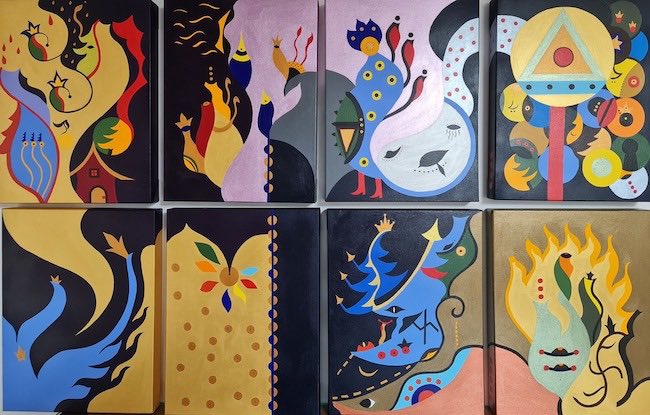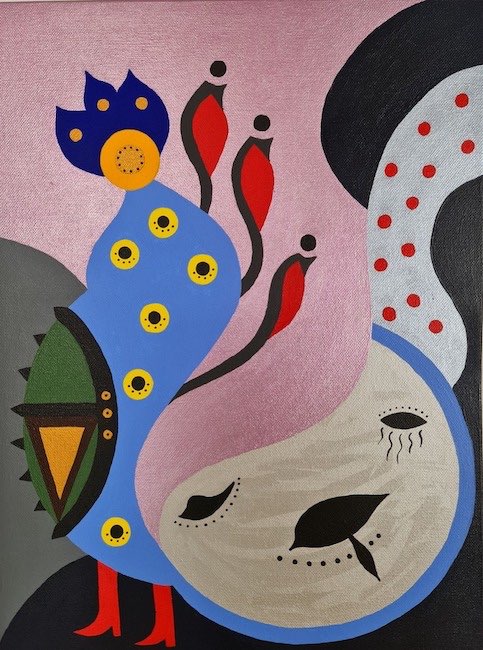Alcuni artisti avvertono la necessità di fuggire da tutto ciò che lo sguardo vede nella quotidianità perché creando un mondo diverso, semplificato nella figurazione e certamente più orientato a rappresentare una realtà differente, costituisce per loro il modo migliore per poter affrontare tutto ciò che appartiene a una quotidianità scoraggiante, insoddisfacente, a volte persino spaventosa per una delicata interiorità che tende a metabolizzare con difficoltà i cambiamenti e gli stravolgimenti che inevitabilmente nella vita personale, come in quella comune, si verificano. Tra questi creativi vi è anche la protagonista di oggi che sceglie un linguaggio stilizzato e semplice per manifestare emozioni e sensazioni che le consentono di mettere in luce concetti che diversamente, o in maniera più realista, non riuscirebbe a esprimere.
La modificazione formale della realtà osservata, la sua addirittura completa destrutturazione, fu una caratteristica comune a tutti gli artisti dei primi decenni del Ventesimo secolo, quel vivace periodo in cui le linee guida tradizionali furono messe da parte per dare spazio alle avanguardie, più affini e allineate con i rapidi cambiamenti di quel periodo. In particolar modo anche quelle correnti che rimasero legate alla figurazione ebbero dei rappresentanti che vollero tendere verso forme più sperimentali, astratte, proprio perché sebbene fossero affini alle linee guida generali dei movimenti a cui scelsero di appartenere, avvertirono comunque l’esigenza di uscire dagli schemi e dar vita a qualcosa di diverso, più personale, più affine alla loro indole. Il Cubismo volle intenzionalmente scomporre le immagini osservate facendole rientrare in quella geometrizzazione che fu di fatto la base dei più estremi movimenti aderenti all’Astrattismo, come il Suprematismo e il Neoplasticismo, mantenendo tuttavia un forte legame con la figurazione che, nelle opere di Pablo Picasso, era deframmentata e mostrata nella sua contemporaneità ed epurata della terza dimensione; eppure una parte del gruppo ebbe un’idea differente rispetto a Picasso e a Braque e si orientò verso un distacco maggiore dalla realtà, verso un recupero totale della vivacità cromatica e verso forme geometriche che comprendevano anche la morbidezza delle curve, osteggiata invece dal Neoplasticismo. Il Cubismo Orfico, questo il nome del movimento di cui furono massimi esponenti Sonia e Robert Delauny, mostrò altre possibilità rispetto all’attaccamento alla figurazione, e oltrepassò l’osservabile per mostrarne la sua musicalità e armonia a prescindere da ciò che poteva essere colto dallo sguardo. Parallelamente il Surrealismo ebbe proprio nell’evasione dalla contingenza la sua base fondante ma si avvalse di uno stile fortemente figurativo e formalmente realista per condurre l’osservatore all’interno di mondi paralleli, di universi onirici fatti di incubi, inquietudini, pulsioni che solo sulla tela potevano fuoriuscire, scenari a volte post-apocalittici per mostrare quanto la mente fosse in grado di uscire da sé e manifestare le paure più segrete. Ma anche nell’ambìto del Surrealismo vi fu una voce fuori dal coro, quella del coraggioso Joan Mirò che piuttosto che descrivere la parte negativa dell’inconscio, si soffermò invece sulla rappresentazione del sogno, di quel contatto con la parte infantile che gli permise di dar vita a opere stilizzate, semplificate appunto, attraverso cui riusciva a sollecitare il ritorno alla fanciullezza dell’adulto e a catturare l’attenzione dei bambini che dalle sue opere si sentivano attratti proprio dall’immediatezza vicina al loro sguardo sul mondo. L’artista russa Valentyna Ohurtsova, naturalizzata italiana dove risiede fin dal 2003, fonde le caratteristiche più estreme dei due movimenti, il Cubismo Orfico e il Surrealismo Astratto di Joan Mirò, introducendo una gamma cromatica vicina a quella utilizzata dai Delauny, ma ritornando a una figurazione in cui le figure principali sono sì stilizzate e contraddistinte da linee curve che terminano con immagini che rappresentano concetti, ma assumono una forma più umana, tondeggiante, anche se inverosimile, come se appartenessero a un universo parallelo.
Il suggerimento dell’artista è dunque quello di non soffermarsi all’apparenza perché anche ciò che si vede ingenuo, lineare nella sua rappresentazione, non è detto che sia anche privo di sostanza o significato; anzi, in realtà è proprio lasciandosi conquistare dall’apparente innocenza e leggerezza che si può più apertamente osservare e scoprire, in un secondo momento, la profondità di un messaggio velato, nascosto tra le righe dei colori, dei personaggi che sembrano usciti da un fumetto per bambini.
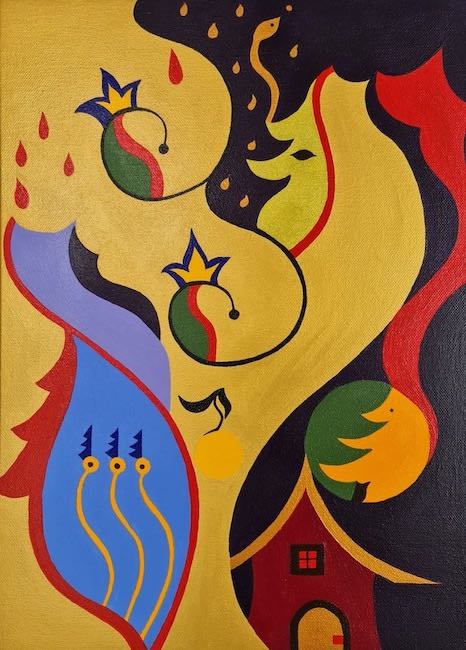
Ma Valentyna Ohurtsova attraverso questo suo lieve linguaggio pittorico comunica con l’osservatore e lo conduce verso le sue profondità, verso messaggi universali attraverso cui rassicura l’essere umano rispetto agli accadimenti della vita, come se volesse sussurrare che in fondo, anche davanti all’evento più negativo e spaventoso, tutto passa, tutto in qualche modo trova la sua soluzione se si mantiene un atteggiamento positivo e aperto alla soluzione.
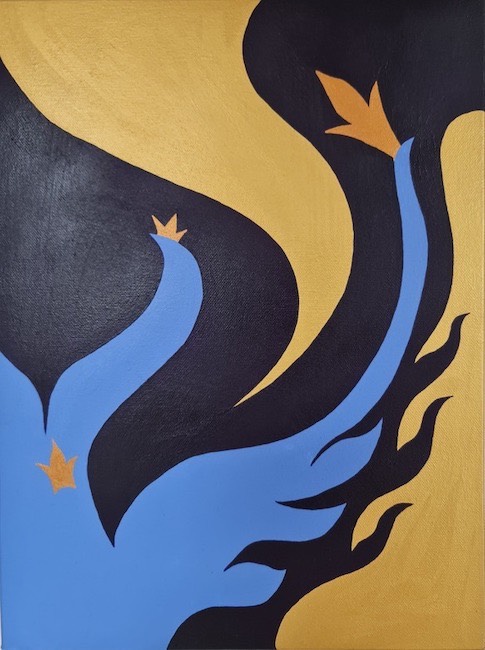
La sua ultima produzione presenta una caratteristica singolare, quella di essere composta da otto tele che possono essere osservate singolarmente oppure nel loro insieme. Il titolo della composizione è Non abbiate paura e mette in luce le fragilità dell’essere umano, le possibilità che possono verificarsi e togliere serenità a un equilibrio apparentemente solido eppure assolutamente fuggevole perché assoggettato al susseguirsi delle circostanze; l’opera può essere un riferimento all’attuale guerra che sta sconvolgendo i popoli europei ma può essere applicata a qualunque conflitto si sia verificato in passato in qualunque parte del mondo perché la precarietà della vita e dell’esistenza emerge in maniera più intensa proprio all’avvicinarsi della possibilità di perdere tutto.
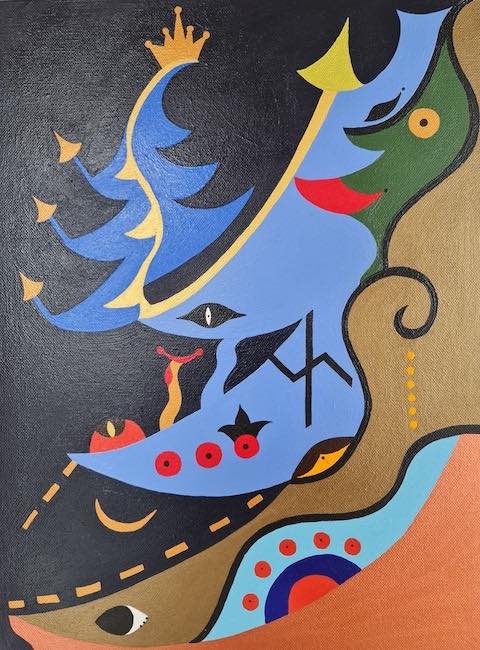
D’altro canto però gli eventi si avvicendano per mettere alla prova la forza interiore, la capacità dell’essere umano di reagire e di uscire anche dalle situazioni più complesse, trovando la forza di ricostruirsi e rigenerarsi; è questo che si evince dalle singole tele che compongono l’opera finale perché prese una a una sembrano indicare tutti quegli episodi che possono avvenire e a cui c’è sempre il modo di reagire. Malgrado la tematica decisamente poco rassicurante, le tonalità scelte da Valentyna Ohurtsova sono sempre solari, intense ma positive, in contrasto con quel fondo nero che sembra costituire una minaccia incombente; eppure l’essere umano, raffigurato con la stilizzazione che contraddistingue l’artista e che sembra in qualche modo alleggerire la cupezza degli accadimenti, ha la possibilità di combattere il buio, di aggrapparsi alla luce e all’atteggiamento costruttivo e reattivo con cui ha la facoltà di cambiare il corso degli eventi, se solo trova il coraggio di crederci davvero.
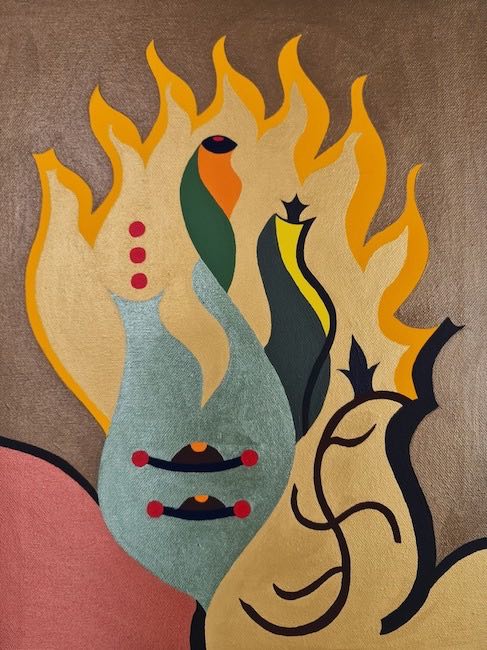
Il fuoco, che è un vento incontrollabile, e che è rappresentato come elemento di disturbo in Non abbiate paura 8, può essere in qualche modo vinto, l’importante è trovare la forza di combatterlo, di trovare una soluzione a qualcosa che appare irrisolvibile; dal punto di vista metaforico quest’opera rappresenta una sollecitazione all’osservatore a riflettere su quanto spesso tutto ciò che sembrava essere senza speranza di soluzione in realtà si è attenuato, risolto e trasformato in un’opportunità per ricominciare, per dimenticare quell’episodio finale da cui poi è giunta un’impensata possibilità di scrivere una nuova storia.
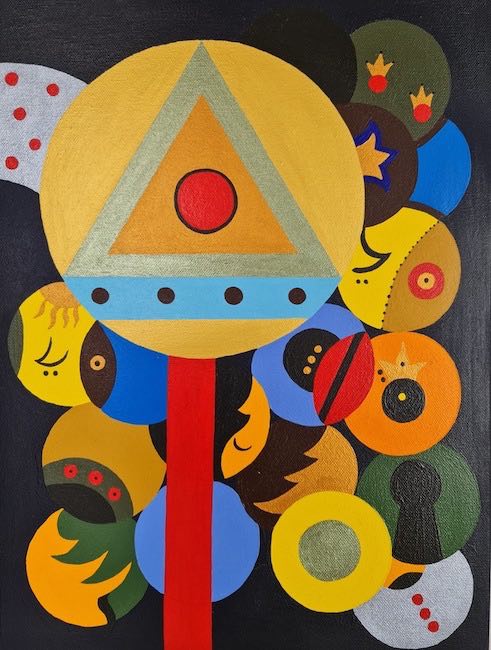
In Non abbiate paura 4 infatti, Valentyna Ohurtsova gioca con gli ostacoli, rappresenta un cartello di stop davanti al quale la maggior parte delle persone si fermano o arretrano, perché un limite difficilmente costituisce la sfida e lo stimolo a essere oltrepassato; eppure, sembra suggerire l’artista, è solo chi riesce a non lasciarsi intimidire o trattenere da un blocco momentaneo che è capace di andare oltre e creare una realtà diversa, più conforme ai propri desideri e alle proprie caratteristiche. Chi resta dietro quel cartello non potrà mai scoprire quanto possa essere bello e positivo inseguire i propri desideri, i propri sogni.
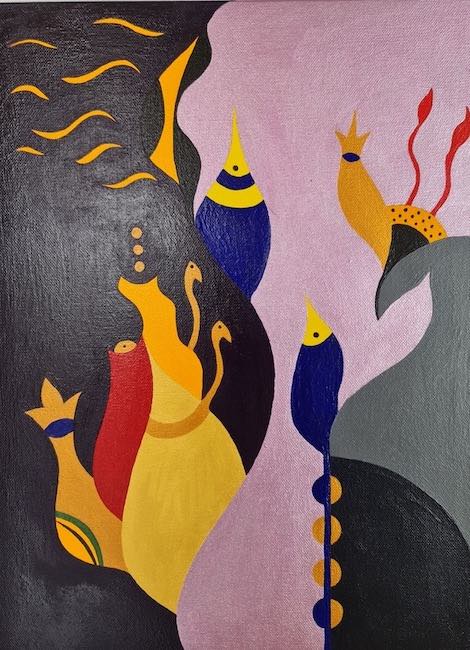
La composizione finale rappresenta in fondo gli alti e bassi della vita, gli eventi che possono susseguirsi e destabilizzare la serenità e la stabilità degli individui e il loro atteggiamento che può essere passivo oppure attivo e dunque risolutivo nei confronti della realtà che di volta in volta si prospetta. Valentyna Ohurtsova dopo una lunga battuta d’arresto del suo percorso artistico, ha da qualche anno trovato una nuova spinta creativa che l’ha condotta a elaborare il linguaggio pittorico attuale in virtù del quale ha ricevuto apprezzamenti dal pubblico e dagli addetti i lavori nelle esposizioni collettive a cui ha preso parte in Italia – Venezia, Roma, Firenze, Milano, Ferrara, Treviso, Jesolo – e all’estero – Copenhagen, Berlino, Parigi, Barcellona, Londra.
VALENYNA OHURTSOVA-CONTATTI
Email: valentynaarte@gmail.com
Sito web: https://valeartohurtsova.com/
Facebook: https://www.facebook.com/valentina.ohurtzova.9
Instagram: https://www.instagram.com/_v.arte_/
The dreamy world of Valenyna Ohurtsova, between Orphic Cubism and Abstract Surrealism to reflect on the events of today’s society
Some artists feel the need to escape from all that the eye sees in everyday life because creating a different world, simplified in figuration and certainly more oriented toward representing a different reality, constitutes for them the best way to be able to deal with all that belongs to a daunting, unsatisfying, sometimes even frightening everyday life for a delicate interiority that tends to metabolize with difficulty the changes and upheavals that inevitably occur in personal life, as in common one. These creatives include today’s protagonist, who chooses a stylized and simple language to manifest emotions and feelings that allow her to highlight concepts that otherwise, or in a more realistic manner, she would not be able to express.
The formal modification of observed reality, its even complete deconstruction, was a common feature of all artists in the first decades of the 20th century, that lively period in which traditional guidelines were set aside to make room for the avant-garde, which was more akin to and aligned with the rapid changes of that period. Especially even those currents that remained tied to figuration had representatives who wanted to tend toward more experimental, abstract forms, precisely because although they were akin to the general guidelines of the movements to which they chose to belong, they nevertheless felt the need to break out of the mold and give birth to something different, more personal, more akin to their character. Cubism intentionally wanted to break down the observed images by making them fit into that geometrization which was in fact the basis of the more extreme movements adhering to Abstractionism, such as Suprematism and Neoplasticism, while nevertheless maintaining a strong link with figuration which, in the artworks of Pablo Picasso, was defragmented and shown in its contemporaneity and purged of the third dimension; yet a part of the group had a different idea than Picasso and Braque and moved toward a greater detachment from reality, toward a total recovery of chromatic vivacity and toward geometric forms that also included the softness of curves, opposed instead by Neoplasticism. Orphic Cubism, this is the name of the movement of which Sonia and Robert Delauny were leading exponents, showed other possibilities than attachment to figuration, and went beyond the observable to show its musicality and harmony regardless of what could be caught by the eye. In parallel, Surrealism had precisely in the escape from contingency its founding basis but used a strongly figurative and formally realist style to lead the viewer inside parallel worlds, dreamlike universes made of nightmares, anxieties, drives that only on canvas could escape, sometimes post-apocalyptic scenarios to show how much the mind was able to come out of itself and manifest its most secret fears. But even in the sphere of Surrealism there was a voice out of the chorus, that of the courageous Joan Miró who rather than describing the negative part of the unconscious, dwelt instead on the representation of the dream, of that contact with the childlike part that allowed him to give life to stylized works, simplified in fact, through which he was able to urge a return to the childhood of the adult and to capture the attention of children who felt attracted by his paintings precisely by the immediacy close to their view of the world.
Russian artist Valentyna Ohurtsova, a naturalized Italian citizen where she has been living since 2003, blends the most extreme characteristics of the two movements, Orphic Cubism and Joan Mirò‘s Abstract Surrealism, introducing a chromatic range close to that used by the Delauny, but returning to a figuration in which the main figures are indeed stylized and marked by curved lines ending with images representing concepts, but they take on a more human, rounded, though far-fetched form, as if they belonged to a parallel universe. Thus, the artist’s suggestion is not to dwell on appearance because even what one sees as naive, linear in its representation, is not necessarily also devoid of substance or meaning; in fact, it is precisely by allowing oneself to be won over by the apparent innocence and lightness that one can more openly observe and discover, at a later time, the depth of a veiled message, hidden between the lines of colors, of characters that seem to come out of a children’s comic book. But Valentyna Ohurtsova through this mild pictorial language of hers communicates with the observer and leads him to its depths, to universal messages through which she reassures the human being with respect to the happenings of life, as if she wanted to whisper that after all, even in front of the most negative and frightening event, everything passes, everything somehow finds its solution if one maintains a positive attitude and is open to the solution. Her latest production has a singular feature, that of being composed of eight canvases that can be viewed individually or as a whole.
The title of the composition is Don’t Be Afraid and it highlights the fragilities of human beings, the possibilities that can occur and take away serenity from a seemingly solid yet absolutely fleeting balance because it is subject to the succession of circumstances; the artwork may be a reference to the current war that is unsettling the peoples of Europe but it can be applied to any conflict that has occurred in the past anywhere in the world because the precariousness of life and existence emerges most intensely precisely as the possibility of losing everything approaches. On the other hand, however, events come one after another to test the inner strength, the ability of human beings to react and come out of even the most complex situations, finding the strength to rebuild and regenerate themselves; this is what is evident from the individual canvases that make up the final work because taken one by one they seem to indicate all those episodes that can occur and to which there is always a way to react. Despite the decidedly unreassuring subject matter, the tones chosen by Valentyna Ohurtsova are always sunny, intense but positive, contrasting with that black background that seems to constitute a looming threat; yet the human being, depicted with the stylization that distinguishes the artist and that somehow seems to lighten the gloom of the happenings, has the possibility of fighting the darkness, of clinging to the light and the constructive and responsive attitude with which he has the power to change the course of events, if only he finds the courage to really believe in it. Fire, which is an uncontrollable wind, and which is depicted as a disturbing element in Don’t Be Afraid 8, can somehow be overcome, the important thing is to find the strength to fight it, to find a solution to something that seems unsolvable; from a metaphorical point of view, this painting represents a solicitation to the viewer to reflect on how often everything that seemed to be hopelessly unresolved actually faded away, resolved, and transformed into an opportunity to begin again, to forget that final episode from which then came an unthought-of chance to write a new story.
In Don’t Be Afraid 4 in fact, Valentyna Ohurtsova plays with obstacles, she represents a stop sign in front of which most people stop or retreat, because a limit hardly constitutes the challenge and the stimulus to be crossed; yet, the artist seems to suggest, it is only those who manage not to be intimidated or held back by a momentary block that are able to go beyond and create a different reality, more in accordance with their desires and characteristics. Those who remain behind that sign will never be able to discover how beautiful and positive it can be to pursue their desires, their dreams. After all, the final composition represents the ups and downs of life, the events that can follow one another and destabilize the serenity and stability of individuals and their attitude that can be passive or active and therefore purposeful towards the reality that from time to time lies ahead. Valentyna Ohurtsova after a long setback in her artistic career, has for the past few years found a new creative drive that has led her to elaborate the current pictorial language by virtue of which she has received appreciation from the public and insiders in the group exhibitions in which she has taken part in Italy – Venice, Rome, Florence, Milan, Ferrara, Treviso, Jesolo – and abroad – Copenhagen, Berlin, Paris, Barcelona, London.


